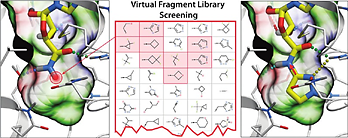

Structure-based Ligand Discovery |
|
|
The third major aspect of my research involves development and application of computational tools for structure-based ligand discovery for GPCR targets. In one of the first examples of prospective screenings for GPCRs, illustrated in Fig.4, we identified 9 novel chemotypes for A2AR antagonists using virtual ligand screening (VLS). Out of 56 candidates selected by VLS, 23 compounds were confirmed as high affinity A2AR ligands. The best compounds reached high affinities (Ki~30nm) and ligand efficiencies (LE>0.35). The discovered hits are suitable for further lead optimization, proving high efficiency of our VLS technology for the discovery of new chemical scaffolds. Our most recent prospective VLS campaign for dopamine D3 receptor (D3R) allowed even higher hit rate (56%) in discovery of D3R antagonists (Fig. 5). Most importantly, this study is also one of the first examples of structure-based VLS specifically targeting allosteric pockets in GPCRs, paving the way for discovery of allosteric and bitopic ligands. |

|

To improve accuracy and reliability of ligand docking and virtual screening (VLS), we have developed a ligand guided receptor optimization algorithm (LiBERO), which allows reshaping of the binding pocket conformation based on known ligands. Apart from employing optimized models in VLS studies, LiBERO and similar technologies have been used in (i) prediction of conformational changes upon agonist binding in ß2 adrenergic receptor (ß2AR), accuracy of which was later validated by the crystal structures of ß2AR- agonist complexes, (ii) blind prediction of a A2AR - antagonist complex (iii) prediction of ligand binding and selectivity in all four Adenosine receptor subtypes and other applications. |
|
In addition to virtual screening, we have been developing technologies for rational structure-based design of ligands and tool compounds with specific functional properties (Fig. 6). Thus we applied systematic structure-based fragment-based derivatization approach to identify new high affinity A2AR ligands based on the adenosine scaffold. The rationally designed compounds were synthesized, and most of them proved to be agonist of A2AR. Some of them also had a partial agonist functional profile, which is rare for A2AR and has potential therapeutic benefits. |

|